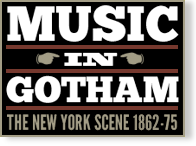Event Information
Venue(s):
Steinway Hall
Conductor(s):
Emilio [conductor, pianist] Agramonte
Price: $1; $.50 extra, reserved seat
Event Type:
Chamber (includes Solo)
Performance Forces:
Instrumental, Vocal
Record Information
Status:
Published
Last Updated:
11 June 2025
Performance Date(s) and Time(s)
08 Oct 1874, 8:00 PMPerformers and/or Works Performed
Citations
Obstructed by a strip of white obscuring about a quarter of nearly the length of the column.
“Notwithstanding the downfall of rain last evening, a very considerable number of persons attended Miss Heilbron’s miscellaneous concert at Steinway Hall. The first piece on the programme was the celebrated Trio in D minor for pianoforte, violin and violoncello by Mendelssohn (Opus 49), the movements of which are as follows [movement details].
The first movement was given with good effect, being played at full speed, with great animation and brilliancy throughout. The passionate agitation and wild onward rush of the triplet passages for the piano-forte contrasted well with the long flowing cantabile phrase for strings, which forms the first subject of this allegro.
The andante was played with great care and attention to the marks of expression, and its lovely, graceful melodies were well displayed.
Mendelssohn’s light and vivacious Scherzo, which followed, was performed with great care and neatness, the smallest details being most distinctly heard. The quick staccato passages were delivered with crispness and point; fully in accordance with the directions of the composer. The passionate, restless allegro movement which forms the finale to this great work was played with unflagging tempo. Its brilliant arpeggio passages for piano-forte were given with considerable fire and energy, and the beautiful melody in the major key, which is first announced by the violoncello, was fully enjoyed by all.
Mlle. Heilbron was ably supported by Mr. Brandt and Mr. Verner. She was warmly received, and loudly applauded at the close of the performance of the trio, and also after playing subsequent pieces. But it must be confessed that she appeared to greatest advantage in the concerted piece, which was played with great accuracy and faultless mechanism; although the quality of the tones produced was unvaried. It is well known that no two piano-fortes, by any one maker, can be found perfectly alike, however similar may be the means employed to produce them. It will therefore not cause surprise that the peculiarities of the American piano-fortes have to be studied deeply by those who would excel on them; that by some slight variations in the touch, all qualities of tone may be produced, as well as all gradations of power of tone. Many solo pianists have gained reputations by successfully exhibiting passages with most delicate variations in the mode of manipulating the instrument, and thus avoiding the monotonous effects which ordinary players produce. We have no doubt that Miss Heilbron will soon add this charm to her style of performance, and thus increase her power to please, which is already great, and is the result of continuous , persevering study, for which alone she is entitled to great praise. The admirable violin performances of Master Leopold Lichtenberg created great enthusiasm. He is exceedingly young, and yet plays like a finished artist. His execution of the ‘Fantaisie Caprice’ by Vieuxtemps, which has been made familiar to all who attend Mr. Thomas’s concerts, was worthy of the highest praise. The tone produced was large, free and full, and greatly varied in quality and intensity. The harmonics were so very strong and crystalline as to resemble the effect produced by musical glasses. The shakes were brilliant; the chords and passages in sixths and octaves were all perfectly in tune, and so much intelligence was displayed in the phrasing and the playing of this elaborate music entirely from memory that Master Lichtenberg must be already regarded as a remarkably good concert player. He is from California, and was a pupil of Wieniawski. On being encored he gave a mazourka of his master’s, entitled ‘Kuyawick.’ We hope that ere long he will soon be heard again in public, that Bach’s violin music may have a good interpreter. Miss Heilbron received valuable co-operation from Miss Rosburgh, Signor Ardavani and particularly from Mr. Parsons, with whom she played Moscheles’ celebrated duet for two pianos, entitled ‘Homage a Handel,’ to the entire satisfaction of the audience, in which were many of her friends and admirers.”
“A young pianist made her debut in this city last night in Liszt’s transcription of the waltz from Gounod’s ‘Faust.’ She is a cousin of the prima donna of the Strakosch Italian Opera Company, and is young, handsome and talented. In the stormy setting of the ‘Faust’ waltz, with its peculiar Liszt passages, Miss Heilbron made a success of the most decided kind. Her playing may be characterized as neat, finished, crisp and full of expression. There is none of the rudeness of the average young girl at the piano, no thumping nor indistinctness, but a clear, quiet, tasteful interpretation of a work. Miss Heilbron made a success of the most unequivocal kind last night. Master Lichtenberg, a little boy all the way from California, appeared as a violinist on the occasion and essayed Vieuxtemps’ ‘Fantasie Caprice,’ an extremely difficult test for any violinist. The little boy proved himself an artist, although in embryo, of the true kind. His tone is pure and his execution correct in every particular. In the middle of the fantasie the bridge of his violin gave way and he sturdily went back to the artists’ room and came out with a fresh fiddle and finished the work with éclat. We understand that this boy will go to Europe shortly, under the patronage of a prominent German banker, to complete his studies under Wieniawski. He has all the qualities calculated to make a great artist. The other artists who took part in the concert were Miss Ida Rosburgh, soprano; Mr. Brandt, violin; Mr. Charles Verner, violoncello; Mr. Parsons, piano, and Mr. Agramonte, conductor.”

